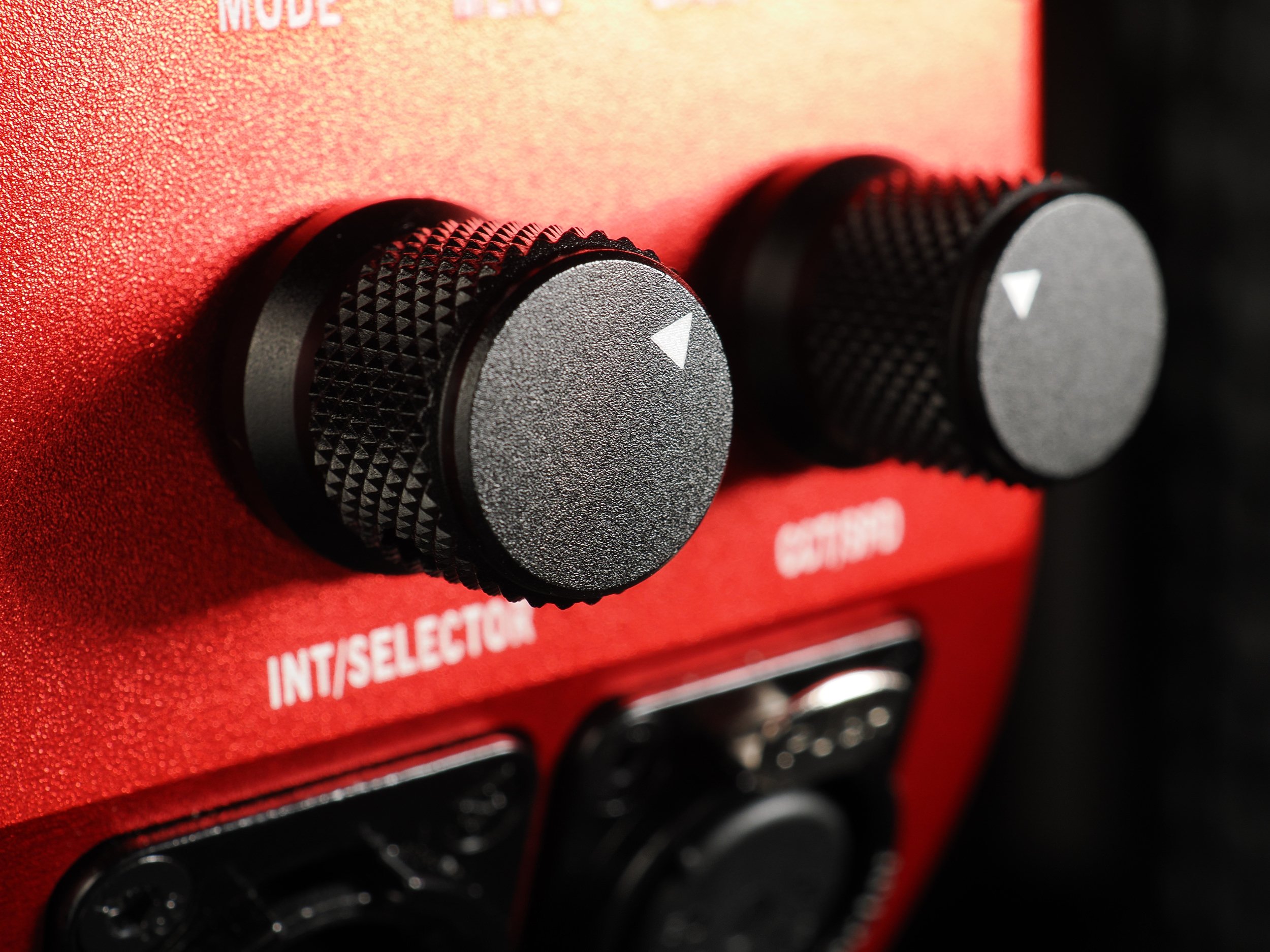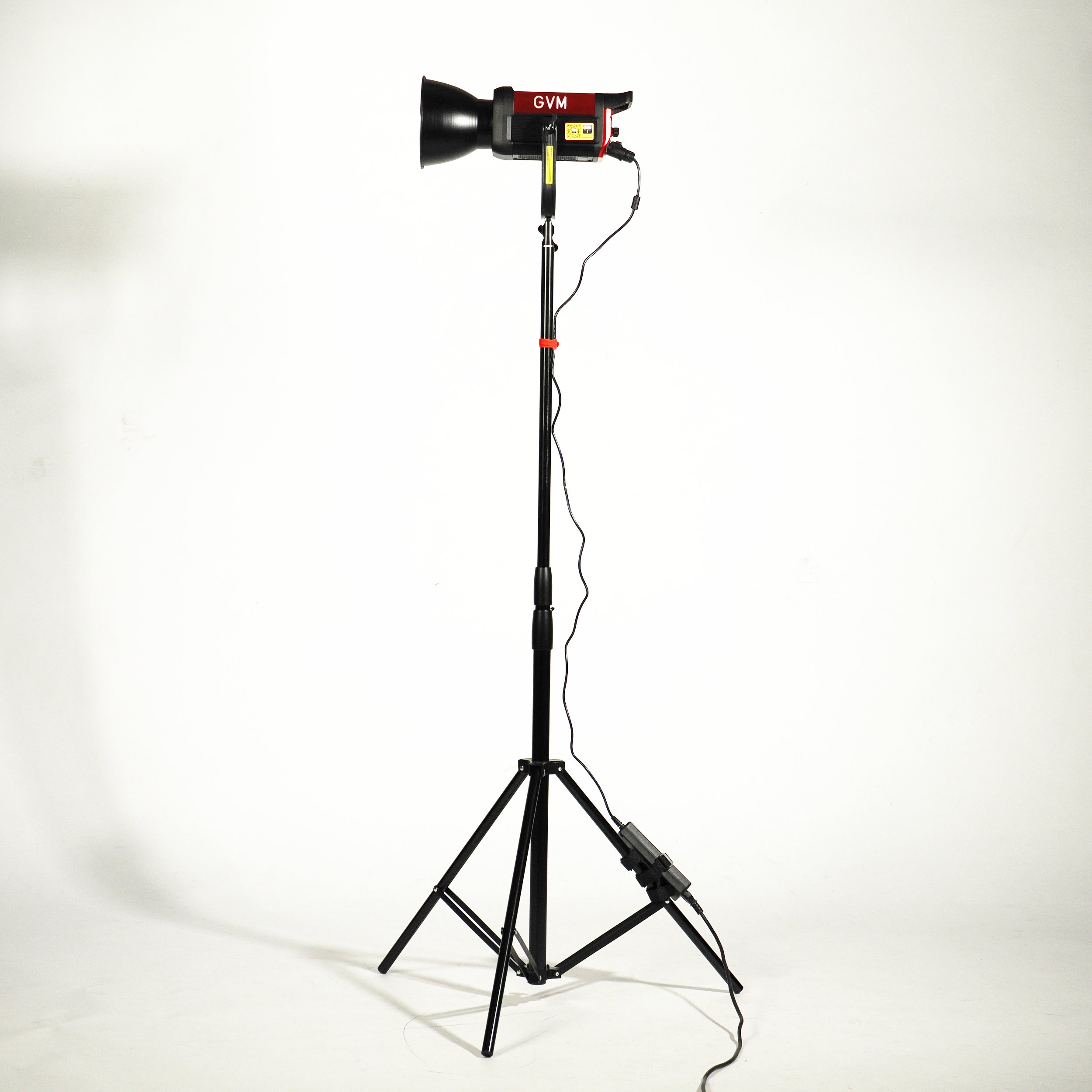GVM PRO SD300B
GVM PRO SD300B
1 Introduction
The GVM-PRO-SD300B is a bi-color LED for professional filmmakers and photographers.
When it comes to lighting equipment, my expectations are very high as no post production trick can fix bad lighting. I’ve acquired the SD300B specifically to light numerous projects over the last months as well as to conduct lab tests of photographic equipment.
This brings me to the question: Did the SD300B earn its keep? Find out in this review which includes detailed performance parameters and a complete evaluation of the light’s features and functions.
GVM PRO SD300B - detail
2 Specifications
Type: Circuit on board bi-color LED monolight
CRI ≥97
Color temperature: 2.700-6.800K
Brightness: 11.800 lux/1m (bare), 44.500 lux/1m (standard cover)
PWM frequency: 15kHz (adjustable up to +2kHz in 100Hz-increments)
Nominal power: 300W
Power supply: DC (via AC/DC converter, included)
Heat dissipation: Heat sink and internal fan
Bayonet: Bowens
Controls: Direct, DMX, Smartphone App
Material: Aluminum alloy chassis with engineering-grade plastic elements
Weight: 2.7kg
Size: 29 × 13 × 13cm
Country of origin: PRC
3 Quality of Light
When it comes to quality of light, the GVW SD300B could be described with one word: Excellent.
At Kelvin settings from 3.200 to 6.800K, the light constantly delivers a CRI of at least 96, even after 10 hours of continued use. Only at 2.700K, the average CRI is slightly below 95, which is still more than enough even for critical work. The manufacturer’s average rating of 97 is well justified and grounded in reality.
Average CRI at various Kelvin-Settings. Green = CRI 97; Red = CRI 96
Just like the CRI, the maximum power delivery varies slightly with the set Kelvin setting. The highest measured difference was half a stop between 5.000K and 2.700K. It is important to underline that this is a very minimal variation for a bi-color light and deserves the attribute “negligible”.
Examining maximum light output at 5.000K at 1m the measured EV100 for the bare bulb was 12 EV and 14,4 EV with the standard reflector. Again, this is in line with the manufacturer’s specifications.
GVM PRO SD300B - LED detail
Regardless of brightness or Kelvin setting, the light never switches to a 100% duty cycle, most likely to ensure stable light output across the whole Kelvin range. With low quality LEDs, this can be a problem as the pulse width modulation (PWM) frequency might interfere with the recording equipment. The GVM-PRO-SD300B, however, utilizes a relatively high PWM frequency of 15kHz. For an off the shelf product, this is very high and definitely above average.
Indeed, 15kHz is an excellent frequency as it is an integer multiple of both 25/50 and 30/60. This is also the reason why the average filmmaker will perceive these lights as essentially flicker-free, although they technically aren’t. To illustrate the capabilities of the unit I calculated various frame rate/shutter speed combinations, which I lab tested for being 100% flicker free:
60p/50p, S.S. 1/12.800s
24p, S.S. 1/5.000s
Theoretically, these settings can be pushed even further, not least because of one remarkable feature of the GVM-PRO-SD300B: Its flicker frequency is user-adjustable in +100Hz increments up to a maximum of +2.000Hz. Thanks to that, the flicker frequency can be fine-tuned to any frame rate and ultra-fast shutter speed one would possible use on set.
Frequency adjustment
On top of that, even mixing the light with low quality lights or regular household lights is a breeze, as the GVM can be easily adjusted to match the flicker frequencies of those.
Apart from flickering, another common weak point of many lights is stable power delivery. While I occasionally noticed a ripple when changing the power output quickly in large increments, the flow of current during regular operation was always perfect, even after hours of continued use.
4 Build Quality and Design
GVM PRO SD300B - top view
The light itself is made out of aluminum alloy and engineering-grade plastics. Manufacturing tolerances are low and there is no squeaking or undesirable play.
GVM PRO SD300B - control knobs
Buttons and knobs exhibit rich, mechanical feedback, making them easy to operate under all circumstances.
GVM PRO SD300B - fastening screw
The lateral fastening screws are made out of unusually hard plastic, which gave me the impression that they might break when over-tightened. After intense use, I now know that my initial reservations were unjustified, as they are still perfectly fine.
What immediately caught my attention was the high quality rubber cable leading to the power brick. The thick rubber has “heavy duty” written all over it. Same goes for the brick and the cable leading to the light itself. I only wished for the latter being a bit longer. At the given length, the AC/DC converter has to be fixed to the light stand at regular working heights, otherwise it would dangle in the air and damage the connector. Thankfully, GVM included a fixation which is not an elegant solution, but a practical one.
GVM PRO SD300B - cable length
GVM PRO SD300B - power brick with fixation
Two additional design features are worth mentioning: First, the standard Bowens bayonet, and second, the GVM logo on the left side of the light. The latter lights up every time when the SD300B is turned on, which might be viewed as convenient by some and as annoying by others
GVM PRO SD300B - logo (daylight)
GVM PRO SD300B - logo (night)
5 Operation
The light offers three modes of operation:
CCT
Color matching
Light effects
GVM PRO SD300B - mode selection
CCT, which stands for correlated color temperature, is the standard mode for most situations. It lets you pick a Kelvin setting anywhere from 2.700K to 6.800K.
Color matching allows the selection of one of twelve preprogrammed light source profiles. It sounds like a gimmick but it is not. I’ve tested and used used the profiles and they are practically set-and-forget
GVM PRO SD300B - color matching modes
Light effects is the mode I used and tested the least, it simulates one of twelve dynamic light effects.
GVM PRO SD300B - light effects
The power output of the light can be adjusted in 1/1.000 steps from 0% to 100%. The light responds almost perfectly linear when being dimmed, as the lab test revealed. Additionally, various dimming curves are selectable in the menu.
Dimming curve
Internal heat sinks and the built-in fan deliver excellent cooling, the latter being reasonably quiet. Fine tuning via the menu is possible.
One nice feature is the “COOL” button on the rear. Pressing and holding it turns off the light and starts a cooling sequence, which automatically stops once the light is safe to touch. Pressing and holding the same button again brings it back up.
GVM PRO SD300B - cool button
Personally, I operate my lights mostly by walking up to them and using the controls on them directly, but should connectivity be required, the user has the option to choose from either DMX, a smartphone app or a Bluetooth daisy chain.
6 Verdict
To answer the initial question, whether the SD300B earned its keep or not, I can confidently state: Yes.
Quality of light, performance, user experience and overall practicability are excellent and I would be hard pressed to come up with any significant negatives.

















